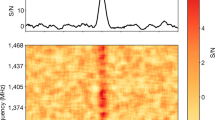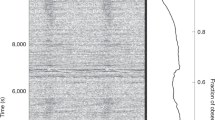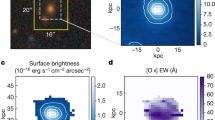Abstract
In the accompanying letter1, we have reported the discovery of two nonthermal radio sources lying near the galactic plane, which have surface brightness distributions radically different from those of the supernova remnants (SNRs) with which they had been formerly classified. Their marked axial symmetry, associated compact com ponents, steep surface-brightness gradients and polarization structure are unlike those seen in any previously-identified class of radio emitters. Here, we discuss some of their physical properties (distances, ages, energetics) and describe briefly a scenario in which the observed radiation is produced by electrons generated in a relativistic outflow from high-velocity accreting binary systems.
This is a preview of subscription content, access via your institution
Access options
Subscribe to this journal
Receive 51 print issues and online access
$199.00 per year
only $3.90 per issue
Buy this article
- Purchase on Springer Link
- Instant access to full article PDF
Prices may be subject to local taxes which are calculated during checkout
Similar content being viewed by others
References
Becker, R. H. & Helfand, D. J. Nature 313, 115–118 (1984).
Weiler, K. W. & Pangia, N. Astr. Astrophys. 90, 269–282 (1980).
Reynolds, S. & Chevalier, R. Preprint (National Radio Astronomy Observatory, 1984).
Becker, R. H. & Helfand, D. J. Astrophys. J. 283, 154–157 (1984).
Helfand, D. J. & Becker, R. H. Proc. Conf. Crab-like SNR USA (in the press).
Helfand, D. J. & Becker, R. H. Nature 307, 215–221 (1984).
Radharkrishnan, V., Goss, W. M., Murray, J. D. & Brooks, J. W. Astrophys. J. Suppl. 24, 49–121 (1972).
Lang, K. R. Astrophysical Formulae 39 (Springer, New York, 1974).
Fomalont, E. B., Geldzahler, B. J., Hjellming, R. M. & Wade, C. M. Astrophys. J. 275, 802–807 (1983).
Margon, B., Grandi, S. & Downes, R. A. Astrophys. J. 241, 306 (1980).
Dowthwaite, J. C. et al. Nature 309, 691–693 (1984).
Protherve, R. J., Clay, R. W. & Gerhardy, P. R. Astrophys. J. Lett. 280, L47–L50 (1984).
Lamb, R. C., Godfrey, C. P., Wheaton, W. A. & Turner, T. Nature 296, 543–544 (1982).
Geldzahler, B. J. et al. Astrophys. J. Lett. 273, L65–L69 (1983).
Molnar, L. A., Reid, M. J. & Grindlay, J. E. Nature 310, 662–665 (1984).
Rees, M. J. A. Rev. Astr. Astrophys. 22, 471–506 (1984).
Yusef-Zadeh, F., Morris, M. & Chance, D. Nature 310, 557–561 (1984).
Author information
Authors and Affiliations
Rights and permissions
About this article
Cite this article
Helfand, D., Becker, R. Origin of the new axisymmetric radio sources. Nature 313, 118–119 (1985). https://doi.org/10.1038/313118a0
Received:
Accepted:
Issue Date:
DOI: https://doi.org/10.1038/313118a0
This article is cited by
-
New pulsar/supernova remnant associations
Journal of Astrophysics and Astronomy (1995)
-
Unusual interaction of the high-velocity pulsar PSR1757–24 with the supernova remnant G5.4–1.2
Nature (1991)
-
Unusual radio arcs discovered in the radio source G318.9+0.4
Nature (1990)
-
Is the G18.95–1.1 radio source a shell-type supernova remnant with a central object?
Nature (1988)
-
A revised reference catalogue of galactic supernova remnants
Astrophysics and Space Science (1988)
Comments
By submitting a comment you agree to abide by our Terms and Community Guidelines. If you find something abusive or that does not comply with our terms or guidelines please flag it as inappropriate.



